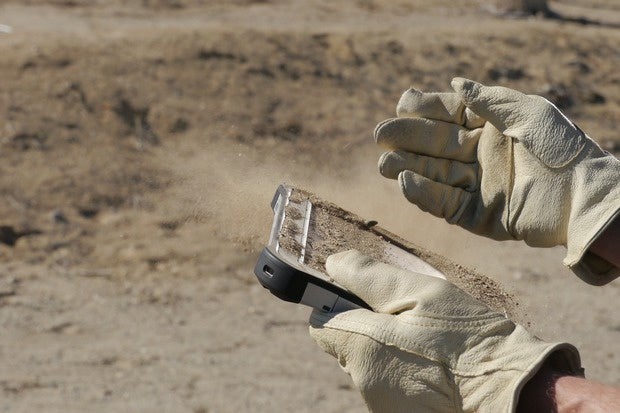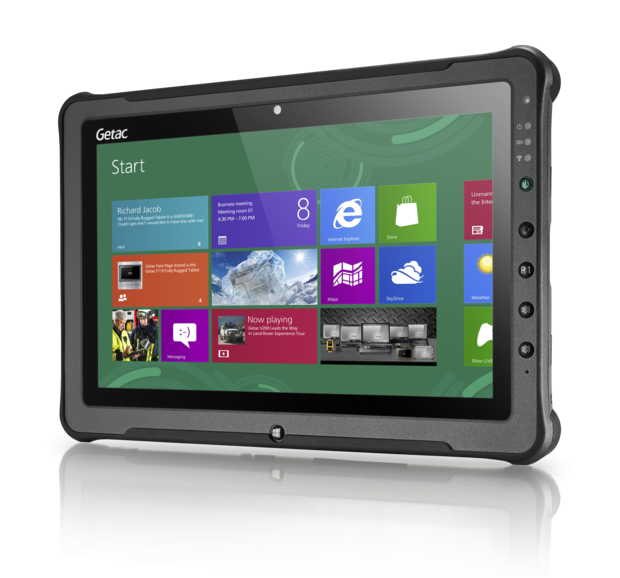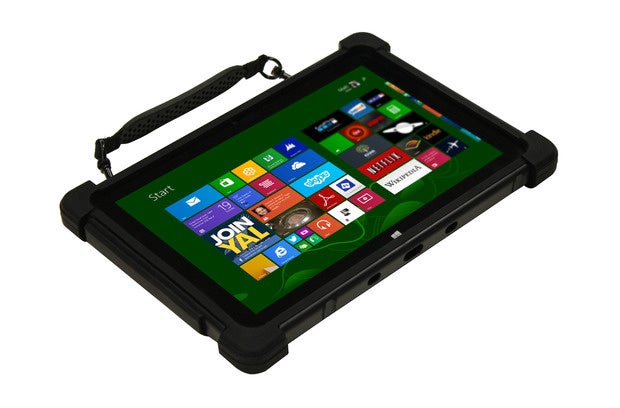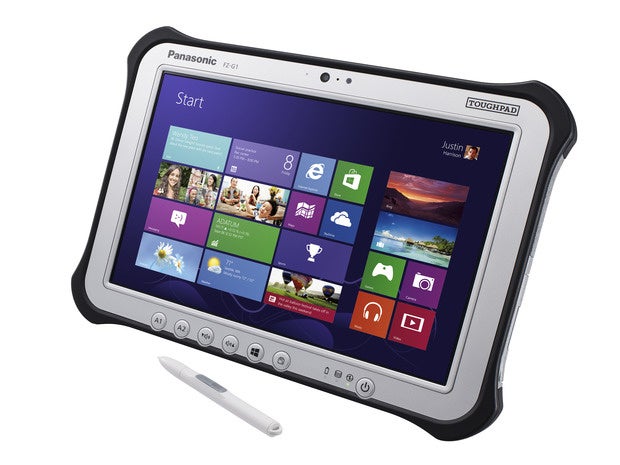Laptop Tablet 2 In 1 Test
Review: Rugged Tablets
Pause me if you lot can: four rugged tablets put to the test
These four tablets -- three Windows and one Android -- will take a licking and keep on ticking.

It's a cruel world out there for tablets: Every twenty-four hour period, there's the possibility they will exist dropped, knocked, spilled on or simply shaken effectually. And that's but in a normal business day -- if you lot utilize your tablet outdoors, while traveling or in a piece of work zone, the odds of a disaster become up precipitously.
In its report Mobile Device TCO Models for Line of Business concern Solutions, VDC Inquiry estimates that the failure rate for conventional tablets in the workplace is 18% per year. That translates into roughly ane in five systems failing at piece of work each twelvemonth.
"Unless you desire to care for tablets as dispensable, this failure rate should be unacceptable for businesses today," observes David Krebs, executive vice president at VDC Research. "Past contrast, rugged tablets have been congenital for concern use and take a 4% failure charge per unit."
Rugged tablets offer reinforced frames, tough skins, watertight seals, hardened glass, soft corner bumpers and major components that are shock-mounted. In other words, if ordinary consumer tablets can be considered sports (or economy) cars, rugged tablets are tanks.
To see what the current state of the art is for rugged tablets, I gathered together three of the newest Windows-based worker-proof slates: the Mobile Demand xTablet Flex 10, the Getac F110 and the Panasonic Toughpad FZ-G1. I also tried out Samsung'south Galaxy Tab Active, a reinforced Android tablet.
Coming together a standard
The gold standard for ruggedness is the Armed forces Standard 810G rating (also known every bit MIL-STD-810G), a set of protocols that the U.Southward. Department of Defense uses to assess mobile computers. The 810G standard specifies a diverseness of trials, including 48-in. drops onto two inches of plywood over concrete, ill-treatment from temperature (high and depression), and tests for resistance to humidity, altitude and vibration.
All three of the Windows tablets tested hither meet the 810G drop standard. Ii -- the Getac and Panasonic -- meet all the 810G requirements as well as the IP65 standard confronting intrusion past dust and jets of liquid. The Android-based Samsung Galaxy Tab Active (which is more of a ruggedized consumer tablet) isn't certified to meet any of the 810G standards but is certified to the IP67 standard, which ways information technology tin withstand dust and immersion in h2o.
The cost for this robustness is that the systems are significantly larger and heavier than their consumer-oriented cousins. For instance, while the current 9.7-in. iPad Air 2 weighs just under a pound and is near a quarter of an inch thick, the smallest and lightest of the three Windows systems reviewed here is one inch thick and weighs twice as much.
The Galaxy Tab Active, at 1.1 lb., is closer to consumer proportions just is still heavier than less sturdy tablets such every bit the iPad Air 2 and Samsung's own 8.4-in. Milky way Tab Southward, which weighs 10.37 oz.
There's another approach to making a tablet closer to beingness indestructible: Encase information technology in a protective cover that can blot the shock of a fall and go on h2o out. However, the combined organisation and pad are often bigger and heavier than a fully rugged tablet. For instance, HP sells a version of its ElitePad 1000 tablet that is protected past a rugged plastic case; the tablet ends up weighing more than 3 lb. and is ane.3-in. thick.
Finally, protection doesn't come cheap -- nigh rugged systems can exist priced at two or three times as much as their conventional cousins. "But getting a tablet meant for consumers is a false economy at work because it will likely toll more in the long run to employ," says VDC'south Krebs. "At work, a rugged tablet tin can apace pay for its extra upfront price."
Brian Nadel shows the states the four rugged tablets and demonstrates how he tested them.
In social club to meet how well these tablets operate in both normal and stressful conditions, I put each through a series of tests for ruggedness (during which they were dropped, shaken and soaked), performance, battery life, usability and and so on. All the tablets survived with flying colors.
Getac F110
Easily the biggest, heaviest and most expensive of the tablets reviewed here, the Getac F110 is built to take a chirapsia. The tablet has a textured polycarbonate case that'due south built on a firm magnesium frame; around its border, polycarbonate and ABS plastic bumpers are molded into the case. The screen is made of Gorilla Glass 2. The ports are covered, and there's a sealed docking connector on the bottom.
 Getac
Getac Getac F110
At 3.1 lb. and i.0 10 12.3 x eight.1 in., the Getac needs a chip of muscle to deport it around. It's roughly a pound heavier than the Flex 10 or the Panasonic Toughpad, and is three times as heavy as an iPad Air 2. As a upshot, while carrying it, I frequently establish myself looking for a table to piece of work on. Getac offers an optional hand strap to help comport it and docks for your desk-bound or vehicle.
The 11.half dozen-in. brandish offers 1366 x 768 resolution. At 376 candelas per square meter, the Getac is brighter than the Flex ten simply 27% darker than the Panasonic. I likewise found it less usable in direct sunlight than the Panasonic.
The Getac has a tethered stylus that snaps into a recessed spot in the back of the unit of measurement. Because the bumpers rise 0.1 in. above the display, writing or drawing on the screen felt awkward at times. I much preferred the Panasonic's near-flush case.
On the right side is a port door that protects the Getac's USB 3.0, HDMI and sound connectors. It's the just one of the three to have a latch on the door to lock it shut.
In addition to an on/off push button, a Windows push button and one for locking the screen, at that place are keys for adjusting the volume and a programmable button for opening a specified app.
There's a forward-facing Hard disk camera and a 5-megapixel back-facing camera. I tried the latter, and found that its images were sharp and clear; they can be GPS tagged for location, which can exist helpful for a variety of employees, such as insurance adjusters or an oil rig repair crew.
There are a number of optional features that can be added to the Getac, including a micro-SD bill of fare slot, USB 2.0 or RS-232 serial ports, a barcode scanner and 3G/4G capability.
The tablet's Core i7 4600U processor runs between 2.1GHz and 3.3GHz and includes Intel's vPro security protocols; there's a Core i5 option that'due south about $200 less expensive. The review unit of measurement came outfitted with 4GB RAM merely tin can agree up to 8GB; it comes with 128GB of internal SSD storage and is available with 256GB.
The Getac's two 2160mAh batteries kept information technology powered for 7 hours and xl minutes of continuously playing HD videos from a USB key. That should exist more enough for a full workday of normal usage -- and you can alter the batteries i at a time, something that few notebooks can do.
The organization includes Windows 8.ane Pro and the company's ain 1000-Managing director software, which consolidates configuration settings and has a handy status screen that shows everything from CPU usage to the battery level.
The Getac F110 comes with a three-yr warranty that includes accidental damage. (Assuming you need it; the Getac passed our torture test without a hitch.)
Lesser line
If your piece of work requires a large-screen rugged tablet, then the Getac F110 is potent enough to provide years of reliable operations.
MobileDemand xTablet Flex 10
While it could hardly be considered slim and light, Mobile Need'due south xTablet Flex ten comes shut to mimicking a consumer tablet while remaining rugged.
Made of smooth polycarbonate plastic, the Flex 10'south case feels solid. Inside, its major components are bolted together to form the equivalent of an internal frame. The system has a sealed docking connector and silicone tabs to continue dirt, water and grit out of its ports. There are soft silicone bumpers to protect it from driblet damage, but they fit loosely at the corners and extend 0.2 in. in a higher place the screen, making it a chip bad-mannered to work with the screen.
 MobileDemand
MobileDemand MobileDemand xTablet Flex x
At 1.0 x 10.eight x 7.4 in. and 2.0 lb., this is the smallest and lightest of the Windows rugged tablets and the easiest to carry around. I really liked the Flex ten's included mitt strap, which attaches to the back of the unit and fabricated information technology easier to hold and use the screen while standing. In that location's too a fabric handle that clips to small holes in the case.
The system'southward 10.1-in. screen (1920 10 1200 resolution) has chemically hardened glass and an oil-resistant coating that keeps fingerprints to a minimum (but seems to attract a lot of dust to the surface). Overall, the Flex 10'due south screen looked tedious in straight sunlight compared to the others. It too was the least bright of the three Windows tablets (and roughly equivalent to the Galaxy Tab Active) at 322 candelas per foursquare meter of illumination.
The speaker in the back is open to water seeping in; unlike the other 2 Windows tablets, the Flex 10 isn't IP65 rated. Every bit a event, it is more appropriate for uses that involve only occasional outdoor activities or exposure to wet.
The system's case has an on/off button, volume keys and a prominent Windows central on the bottom front panel (when belongings the tablet horizontally); you need to firmly printing your thumb on it to get information technology to work. The Flex ten lacks the programme commencement-up push that's on the other Windows tablets.
It comes with a front-facing HD camera and a back-facing 5-megapixel camera; there is no geo-tag characteristic for its images. I found that its video wasn't every bit clear as that offered by the others.
Information technology leads in terms of ports: The Flex 10 comes with a micro SD card slot also as one USB ii.0 and one USB 3.0 port. It also has an HDMI and an audio connector. In that location's a stylus that can be tethered to the unit of measurement. The unit of measurement itself doesn't have a slot for the stylus; instead, the tablet and the pen slide into a flexible cloth sleeve.
The review unit came with a quad-core Atom Z3770 processor that runs between 1.5GHZ and 2.4GHz; the company is planning to motility to the newer Z3775 processor within a couple of months. It was also equipped with 4GB of RAM and 64GB of SSD storage infinite.
After I dropped, spilled on and shook the arrangement, the Flex 10 was unscathed, although the silicone edging came loose (simply it was like shooting fish in a barrel to push it dorsum). The criterion score of 537.6 was lower than that of the other ii Windows systems I tested.
The Flex 10's 7400mAh battery powered the arrangement for five hours and 15 minutes of continuous playback of videos from a USB key, the shortest of the 3 Windows tablets. Information technology does take one advantage: It uses a micro-USB port for charging and comes with an AC adapter that's the smallest of the agglomeration.
It includes Windows 8.1 with Bing, and comes with a one-year warranty; an extra year of coverage costs $95.
Lesser line
The Flex 10 sells for an attractive $695. Although it's non as fast or equally watertight as the other tablets reviewed here, for the money, the Flex ten offers a skilful amount of ruggedness.
Panasonic Toughpad FZ-G1
Panasonic's Toughpad FZ-G1 provides the most protection per pound of the tablets reviewed hither while delivering surprisingly potent performance.
That'southward because, rather than using a plastic skin, the Toughpad is built around a sturdy magnesium frame and example, while its major components have been flexibly mounted to blot the shock of an bear on. The tablet has a 10.1-in. screen made of Gorilla Glass II, sealed covers for ports and protective bumpers. It meets all the MIL-STD 810G tests and has an IP65 waterproof rating.
 Panasonic
Panasonic Panasonic Toughpad FZ-G1
At 0.nine x ten.9 x viii.four in. and 2.2 lb., the Toughpad is well-balanced and relatively easy to acquit and use. Just beneath the screen (if you lot hold it horizontally) are buttons for on/off and volume. There are also ii buttons that can be programmed for any app; when the tablet is shipped, one is set to display Panasonic'southward Dashboard, which consolidates major configuration details such equally battery level and camera status, while the other brings up the on-screen keyboard.
Its front-facing photographic camera tin can capture 720p video, while the rear-facing camera can grab 8-megapixel images and has an LED flash for illuminating dark scenes. It delivered the sharpest images of the three; images can be GPS-tagged.
The Toughpad also led the three Windows tablets as far as the screen is concerned. The 10.1-inch display offers 1920 x 1200 resolution and was the brightest at 480 candelas per square meter of illumination. It handled existence in directly sunlight the best with images that weren't washed out.
The screen can exist used with gloves on, making it more practical for use in low temperatures and rougher tasks. Its bumpers protrude but slightly higher up the screen, making the Toughpad easier for writing, drawing or but checking off Web forms. Information technology comes with a stylus that has a tether and a place to snap it into the back of the case.
It comes with a single USB 3.0 port, one HDMI port and ane audio connector. The tablet besides has a sealed docking port that includes connectors for 3G/4G antennas that can, if you need to, link to a vehicle'southward more powerful antennas.
The Toughpad is equipped with an Intel Core i5 4310U processor that runs betwixt 2GHz and 3GHz. The review unit came with 8GB of RAM and 128GB of solid-state storage space; you lot can upgrade to 64GB of RAM and 256GB of storage space; cocky-encrypting drives are an selection.
The Toughpad suffered no damage during the ruggedness tests; nevertheless, its screen went blank on two of the three 48-in. drops. In each example, the tablet restarted right away with no harm, although I did discover that a petty annoying.
With a 2,179.five rating on the PerformanceTest 8 benchmark, it came in surprisingly close to the Getac's faster processor (likely a consequence of the Toughpad's additional RAM). On the downside, the tablet got noticeably hot at times.
The Toughpad's 4400mAh battery pack powered the tablet for half-dozen hours and 11 minutes of continuous playback of videos from a USB key, which should translate to a full solar day of piece of work. Panasonic has an optional 9300mAh battery pack replacement that sticks about 0.2 in. out of the slate'southward bottom.
Panasonic offers a variety of accessories for the tablet, including desk and vehicle mounting hardware, an optional RS-232 series port, a bar code scanner, a smart card reader, a magnetic stripe reader, and a charger that tin can handle iii batteries.
My favorite, though, is the $350 snap-on iKey Jumpseat Keyboard that tin plough the tablet into a keyboard-centric notebook. It adds a USB port, is just as rugged as the tablet and has backlit keys. The combo weighs iv.2 lb.
Bottom line
Although its three-twelvemonth warranty unfortunately doesn't include accidental damage, Panasonic Toughpad is a good pick for those who want a tablet that is as close to indestructible as is possible.
Laptop Tablet 2 In 1 Test,
Source: https://www.computerworld.com/article/2882568/break-me-if-you-can-4-rugged-tablets-put-to-the-test.html
Posted by: linkegothemend.blogspot.com


0 Response to "Laptop Tablet 2 In 1 Test"
Post a Comment